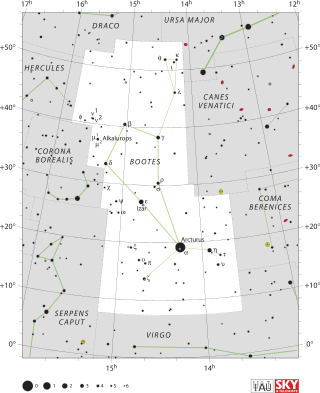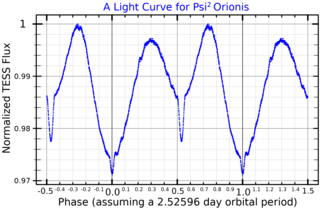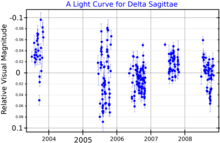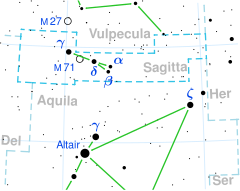
Sagitta is a dim but distinctive constellation in the northern sky. Its name is Latin for 'arrow', not to be confused with the significantly larger constellation Sagittarius 'the archer'. It was included among the 48 constellations listed by the 2nd-century astronomer Ptolemy, and it remains one of the 88 modern constellations defined by the International Astronomical Union. Although it dates to antiquity, Sagitta has no star brighter than 3rd magnitude and has the third-smallest area of any constellation.

W Sagittarii is a multiple star system star in the constellation Sagittarius, and a Cepheid variable star.

Chi Aquarii, Latinized from χ Aquarii, is the Bayer designation of a star in the equatorial constellation of Aquarius. The distance to this star, based upon parallax measurements with a 7% margin of error, is roughly 610 light-years. It is visible to the naked eye with an apparent visual magnitude of about 5.

28 Andromedae is a Delta Scuti variable star in the constellation Andromeda. 28 Andromedae is the Flamsteed designation. It also bears the variable star name GN Andromedae. Its apparent magnitude is 5.214, varying by less than 0.1 magnitudes.

9 Aurigae is a star system in Auriga (constellation). It has an apparent magnitude of about 5, making it visible to the naked eye in many suburban skies. Parallax estimates made by the Hipparcos spacecraft put it at about 86 light-years from the solar system, although individual Gaia Data Release 3 parallaxes place all three components at 88 light years.

Kappa Boötis is a double star in the constellation Boötes. It has the traditional name Asellus Tertius and the Flamsteed designation 17 Boötis. The components are separated by an angular distance of 13.5 arcsec, viewable in a small telescope. Kappa Boötis is approximately 155 light years from Earth.

Iota Canis Majoris, Latinized from ι Canis Majoris, is a solitary variable supergiant star in the southern constellation of Canis Major. It is visible to the naked eye with an apparent visual magnitude that varies between +4.36 and +4.40. The distance to this star is approximately 2,500 light years based on spectroscopic measurements. It is drifting further away with a radial velocity of +42 km/s.

Alpha Sagittae, formally named Sham, is a single star in the northern constellation of Sagitta. Alpha Sagittae is the Bayer designation, which is latinized from α Sagittae and abbreviated Alpha Sge or α Sge. It is visible to the naked eye as a yellow-hued star with an apparent visual magnitude of +4.38. Despite the name, this is not the brightest star in the constellation – that distinction belongs to Gamma Sagittae. Based upon parallax measurements, Alpha Sagittae is approximately 382 light-years from the Sun. It is moving further away from the Earth with a heliocentric radial velocity of 1.7 km/s.
HD 36678 is single star in the northern constellation of Auriga. This star is dimly visible to the naked eye with an apparent visual magnitude of 5.83. It is located at a distance of approximately 840 light years from the Sun based on parallax.

Delta Delphini, Latinized from δ Delphini, is a binary star in the northern constellation of Delphinus. It is visible to the naked eye with an apparent visual magnitude of 4.43. Based upon an annual parallax shift of 14.61 mas as seen from the Earth, the system is located about 223 light years from the Sun.

Gamma Sagittae, Latinized from γ Sagittae, is the brightest star in northern constellation of Sagitta. A single star, it is visible to the naked eye with an apparent visual magnitude of +3.47. Based upon an annual parallax shift of 12.62 mas as seen from Earth, it is located about 288 light-years from the Sun. It is moving closer to the Sun with a radial velocity of −34 km/s.

Epsilon Sagittae (ε Sagittae) is a solitary, yellow-hued star in the northern constellation of Sagitta. With an apparent visual magnitude of +5.64 to +5.67, it is faintly visible to the naked eye on a dark night. It is a variable star with a small amplitude of 0.03 magnitudes. Based upon an annual parallax shift of 5.60 mas as seen from Earth, it is located roughly 580 light years from the Sun. At that distance, the visual magnitude of the star is diminished by an extinction factor of 0.1 due to interstellar dust.

Delta Coronae Borealis, Latinized from δ Coronae Borealis, is a variable star in the constellation Corona Borealis. Its apparent magnitude varies regularly between apparent magnitude 4.57 and 4.69, and it is around 170 light-years distant.
106 Herculis is a variable star in the northern constellation Hercules. It is visible to the naked eye as a faint, red-hued point of light with a baseline apparent visual magnitude of 4.96. Based on its parallax, it is estimated to lie 383 light-years away from the Sun. The star is moving closer to the Earth with a heliocentric radial velocity of -35 km/s.

Sigma Ophiuchi, Latinized from σ Ophiuchi, is a single, orange-hued star in the equatorial constellation Ophiuchus. Its apparent visual magnitude is 4.31, which is bright enough to be faintly visible to the naked eye. The annual parallax shift of 3.62 mas as seen from Earth provides a distance estimate of roughly 900 light years. It is moving closer to the Sun with a radial velocity of −28 km/s.

QZ Puppis is a class B2.5V star in the constellation Puppis. Its apparent magnitude is 4.5 and it is approximately 650 light years away based on parallax.

Psi2 Orionis a binary star system in the equatorial constellation of Orion. It has an apparent visual magnitude of 4.6, indicating that it is visible to the naked eye. Based upon an annual parallax shift of 2.87 mass, it is roughly 1,100 light years distant from the Sun.

V Sagittae or V Sge is a cataclysmic variable in the constellation Sagitta. The system is composed of a main sequence star of about 3.3 solar masses and a white dwarf of about 0.9 solar masses; the fact that the white dwarf is less massive than its companion is highly unusual for a cataclysmic variable, and V Sge is the only super soft X-ray source nonmagnetic cataclysmic variable found so far.

HD 150193 is a binary star system in the constellation of Ophiuchus. The primary star was identified as a Herbig Ae/Be star with a strong solar wind, losing approximately a tenth of solar mass per million years. It does host a very small debris disk, likely due to disk truncation by the nearby stellar companion. The disk is inclined 38±9° to the plane of sky. It appears to be highly evolved and asymmetric, with indications of flattening and grains growth.

11 Sagittae is a blue in the constellation Sagitta with a spectral type of B9III.















